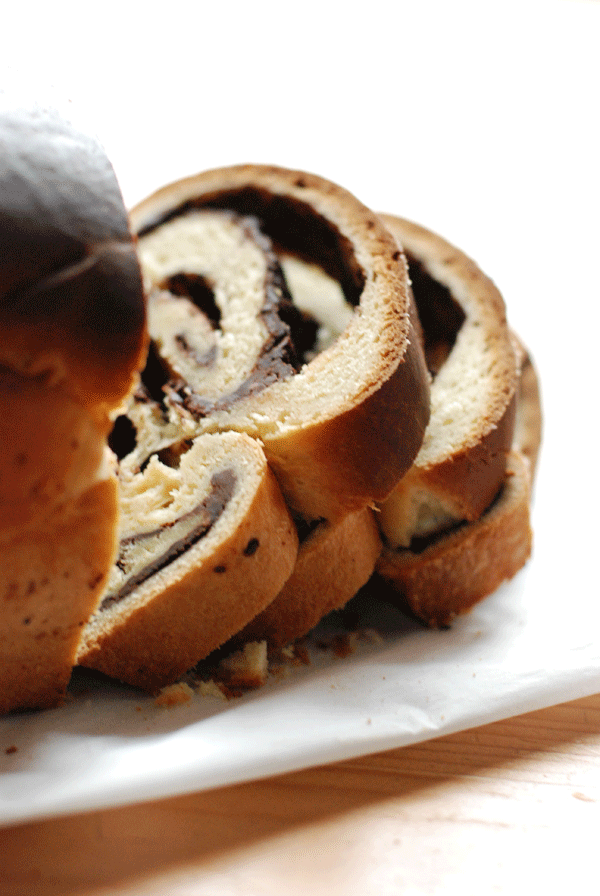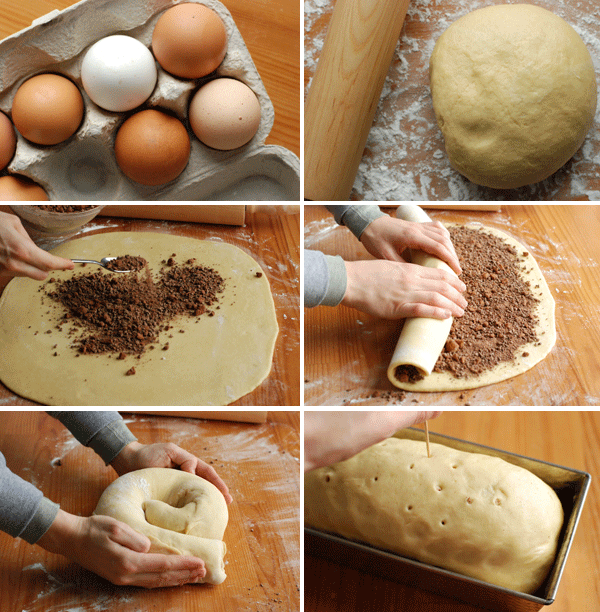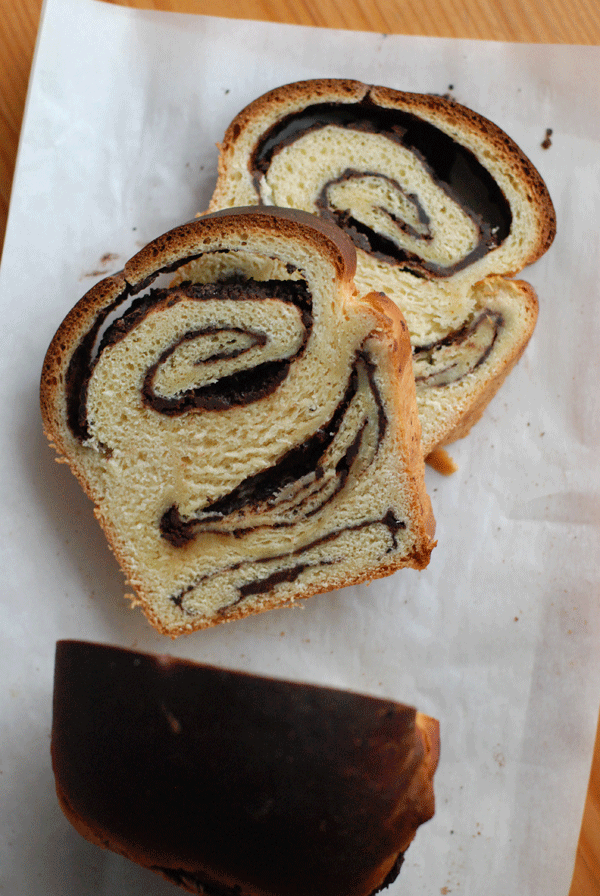 When I was a kid, I couldn't wait for Saturday to come. I'd like to say I loved the break from homework and the chance to spend time outdoors, but really, it was just the Babka. Green's Babka, specifically. The chocolate came in the blue wrapper; if you wanted cinnamon, you went for the green. Inside were many countless sheets of paper-thin dough, folded accordion style as densely as could be, and protectively encasing layers of chocolate. A cross-section had the complex structure of brisket, with all those layers to cut through. I ate mine from the outside in, peeling the layers apart slowly and seeing how thin I could rip each piece. It was quite the treat.
When I was a kid, I couldn't wait for Saturday to come. I'd like to say I loved the break from homework and the chance to spend time outdoors, but really, it was just the Babka. Green's Babka, specifically. The chocolate came in the blue wrapper; if you wanted cinnamon, you went for the green. Inside were many countless sheets of paper-thin dough, folded accordion style as densely as could be, and protectively encasing layers of chocolate. A cross-section had the complex structure of brisket, with all those layers to cut through. I ate mine from the outside in, peeling the layers apart slowly and seeing how thin I could rip each piece. It was quite the treat.
The complex structure of the dessert was etched in my mind. So many layers! And so impossibly thin! However did they do it? For years, I (stupidly) assumed that homemade babka was out of reach. But after a brush with the old-school Green's a couple months back, I was jolted from the romance reminded that Green's is made with wow, so much margarine. And no butter at all. I was convinced that by using the real stuff, I could make an even better version of the childhood classic.
I was right. The babka I made last week, while not really anything like Green's, was delicious. It was less like a croissant and more like a not-so-delicate brioche: soft and buttery, with occasional folds of chocolate and plenty of richness. And seeing as I'm in the middle of a toasting trend, I'll just say it: slices of babka older than a day should be toasted.
This babka comes from Peter Reinhart. Since his pizza dough was such a success, I couldn't resist giving one of his more complex recipes a try. Admittedly, there are a couple rises involved in making this babka, so it's a bit time-consuming and not as hands-off as some of the other baked goods I've been making. That said, the results are sure to elicit oohs and ahhs from your brunch companions. Babka also makes a splendid rustic dessert.
Chocolate Babka adapted from Peter Reinhart
Note: Reinhart suggests a crumb toping that, while traditional, isn't altogether necessary. I omitted it.
2 tablespoons yeast 3/4 cup lukewarm milk 6 tablespoons butter, melted or at room temperature 6 tablespoons sugar 1 teaspoon vanila 4 egg yolks, broken up slightly 3 1/3 cups unbleached all-purpose flour 1 teaspoon salt 1 egg and 1 tablespoon water for egg wash, if using crumb topping
Filling:
1 1/2 cups frozen semisweet chocolate chips or chunks 1 teaspoon cinnamon 1/4 cup cold butter
Streusel Topping:
1/4 cup cold butter 1/2 cup flour 1/2 cup brown sugar pinch salt 1/4 teaspoon cinnamon
In a small bowl, whisk yeast into milk until dissolved and let proof for 5 minutes.
In a large bowl or the bowl of a stand mixer, cream butter and sugar on medium until combined, about 1-2 minutes. Add vanilla to egg yolks, and add to dough in four portions, mixing until combined each time. Once mixed, turn mixer to medium high and continue mixing until uniform and fluffy, scraping down as you go. If using a hand mixer or a spoon, mix as powerfully as possible.
Stop mixing, add flour and salt, and pour in milk mixture. Continue mixing on low until well-incorporated, about 2-3 minutes, until dough is soft and somewhat sticky. If mixer struggles, switch to dough hook or mix by hand.
Transfer dough to floured work surface and continue kneading by hand another 2 minutes, until dough is no longer sticky, but still soft and pliable. Form dough into a ball. Place in lightly oiled bowl, cover tightly with plastic wrap, and let rise at room temperature about 2.5 hours. Dough will rise some, but not double in size.
Meanwhile, prepare filling: grind chocolate in food processor, then add cinnamon. Cut butter into small pieces and add to food processor, mixing until butter is evenly dispersed into the chocolate.
Roll risen dough into 15x15 inch square on lightly floured work surface. Dough should be between 1/4 and 1/8 inch thick. Be sure to lift the dough regularly in between rolls and add flour as necessary to prevent sticking.
Sprinkle filling evenly over dough, leaving 1/4-inch border. Roll up dough and place it seam-side down on work surface. Rock dough back and forth gently to extend roll to about 20 inches long.
Wrap dough around itself to form coil shape. Stand coil on its side, compress lightly to form a loaf shape, and transfer to greased loaf pan. Cover loosely with plastic and let rise at room temperature for 2-3 hours until babka fills out the pan. At this point, either bake babka immediately or refrigerate overnight. BE SURE TO BRING TO ROOM TEMPERATURE BEFORE BAKING!
Preheat oven to 350 degrees. Poke a few holes in top of babka.
If using streusel, combine all ingredients in processor or mix in bowl with pastry blender until it is in small bits. Brush top of babka with egg wash, then sprinkle streusel over top. Bake 25 minutes, then rotate pan and bake until top and sides are dark brown and loaf sounds hollow when thumped, about 25 minutes more. Dough will quickly turn brown, but won't burn; don't panic if it's dark, just check the hollowness and the sides for doneness. Total baking time shouldn't be more than 60 minutes (though depending on your oven, I suppose it may be; trust the dough -- if it sounds hollow and looks deep deep brown, it's probably done).
Let cool at least 90 minutes before serving.

